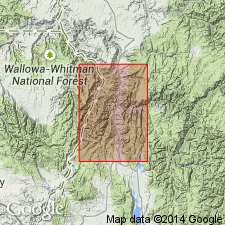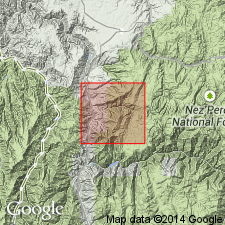
- Usage in publication:
-
- Squaw Creek Schist*
- Modifications:
-
- Named
- Dominant lithology:
-
- Schist
- Phyllite
- AAPG geologic province:
-
- Idaho Mountains province
Summary:
Named as one of four newly named formations and the structurally highest formation of the newly named Riggins Group. Named for Squaw Creek [See Note Below], a tributary to the Little Salmon River. Type section designated along Little Salmon River from Riggins to Captain John Creek, Idaho Co, ID in Idaho Mountains province. Present thickness in Riggins syncline is about 6,000 ft. Overlies Lightning Creek Schist (new) of Riggins north and south of Riggins. Overlies Berg Creek Amphibolite (new) of Riggins Group east of Riggins. Consists of light- to dark-gray phyllite and fine-grained schist. Compositional layering and lamination are conspicuous. Varies in grain size form aphanitic phyllite to medium-grained gneiss. Plagioclase is the dominant mineral and quartz is the next most dominant. Rock types vary widely and intergrade complexly. Were sedimentary rocks derived from source region of volcanic rocks. Schists have been isoclinally folded and extremely sheared. Shown as Paleozoic and Mesozoic age on geologic map. Known to be older than Idaho batholith.
[NOTE: In accordance with Department of Interior's Secretarial Order 3404, discontinuing use of derogatory term squaw, the Squaw Creek Schist is in process of being formally renamed either Yeva Agai Schist or Yeva Agai Naokwaide Schist (BOTH RESERVED). The geographic feature Squaw Creek, from which the geologic name was taken (this report), was renamed Yeva Agai Naokwaide by U.S. Board on Geographic Names, September 2022, USGS GNIS FeatureID 391296.]
Source: GNU records (USGS DDS-6; Denver GNULEX).

- Usage in publication:
-
- Squaw Creek Schist
- Modifications:
-
- Not used
Summary:
Some medium- and high-grade metamorphosed volcanic rocks mapped east of the Salmon River area are mapped as metamorphic units whose relative age and correlation are unknown; these rocks are tentatively correlated with the Seven Devils Group; they are shown as Permian and Triassic age; they are also mapped as present in two plates--the Rapid River and North Fork plates--of the Wallowa terrane. These metamorphosed rocks were previously assigned to formations of the Riggins Group. There is no evidence found during this study to indicate that rocks of the Riggins and the Wallowa are different island arcs. Also, all identifiable map characteristics useful for distinguishing the formations have been obliterated by multiple episodes of metamorphism and deformation. The mapped units cannot be correlated with or assigned to individual formations with confidence. Therefore, the name Riggins and its component formations are not recognized in this study.
Source: Modified from GNU records (USGS DDS-6; Denver GNULEX).
For more information, please contact Nancy Stamm, Geologic Names Committee Secretary.
Asterisk (*) indicates published by U.S. Geological Survey authors.
"No current usage" (†) implies that a name has been abandoned or has fallen into disuse. Former usage and, if known, replacement name given in parentheses ( ).
Slash (/) indicates name conflicts with nomenclatural guidelines (CSN, 1933; ACSN, 1961, 1970; NACSN, 1983, 2005, 2021). May be explained within brackets ([ ]).

